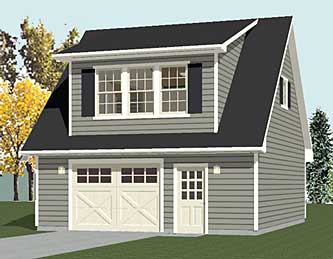Getting a detached garage is a fantastic investment. It gives homeowners the opportunity to add square footage of space to their home and to increase the value of their property. Homeowners are very creative with how they use their detached garage space. Some use it as a home office, while others transform it into a space for hobbies like a wood shop or art studio. Others look to make money off their space by investing in a detached garage with a second floor that can be used as an apartment. By renting out this space, homeowners can get some extra cash through the additional stream of rental income. The first step to having a detached garage built on your property is picking out a set of garage plans. At Behm Design, we provide homeowners with a variety of garage plans to choose from.
Whether you want a small one-car garage or a garage that can fit an auto lift, we have it all! Once the garage is built, it is important that you can use it all year long. If you live in an area with cold winters, it’s critical to make sure that you are able to keep your garage warm so that you can still use it during winter months. Fortunately, there are many options!
Garage Plans Then Insulate, Insulate, Insulate!
The first step to keeping your garage warm all winter long is to make sure it is properly insulated. Insulation is important so that heat isn’t escaping the garage. Sebring Design Build out of Illinois recommends using fiberglass insulation for the garage. They note that this type of insulation is easy for homeowners who are looking to install the insulation themselves. They also state that it typically costs around 50 cents to $1.25 per square foot to insulate the garage. This is a reasonable price when you consider how helpful it will be in keeping heat inside the garage. Insulation can typically keep the temperature of a garage about 40 degrees in the winter. This is a good baseline temperature to have, and it can then be made warmer by the installation of a variety of different heating systems.
Ductless Mini Split System
Mini split units are used in structures that don’t have ducts. An air handling unit goes on the inside of the garage and a compressor goes on the outside. These units are powered by electricity. They typically come with heating and cooling options; that way, you can keep the garage warm in the winter and cool in the summer. The units also usually come with a remote so that you can easily control the heat and AC. While setting up a mini split system isn’t cheap, it is a much less expensive option than having ducts put into your detached garage. If you go this route, be sure to keep up with the maintenance of the system. Ductless mini splits usually require monthly cleanings. A mini split system is a good option if you have an apartment that needs heating above your garage.
Space Heaters
Another easy and affordable option is to invest in some portable space heaters. When it comes to space heaters, there are so many different styles available. For your garage, consider investing in some battery-powered space heaters. That way, you can drag them around the space without having to be near a plug. If you choose an electric space heater, get some extension cords so you can extend the range of where you place the heater. Some space heaters are even solar-powered! Let your heater charge up in the sun and it will be ready to go next time you need it! You can also pick out heaters based on the coverage area. Did you know some space heaters can cover up to 1,000 square feet and more?
Check out Amazon’s extensive collection of space heaters. With their fast shipping, you will have one at your door and in your garage in no time! Keep in mind that space heaters can be a fire hazard if they are not handled properly. Be sure that they are off and unplugged anytime you are not in the garage. Also, don’t put anything too close to the space heaters.
Propane Heater
A propane heater is the perfect way to heat a garage so you can continue to enjoy it all winter wrong. Typically, this is a cheaper option than an electric system. Propane New York describes various types of indoor propane heaters, including portable indoor propane heaters, wall-mounted heaters, forced air propane heaters, and radiant indoor propane heaters. Homeowners must take important safety precautions when using a propane heater in the house. First, make sure a carbon monoxide detector is installed in the garage. Second, be sure that the heater has emergency features like a low oxygen sensor or overheating protection. Just like with space heaters, make sure the propane heater is only on when you are in the garage.
First Step – Garage Plans, Second Step – Heat!
Just because it’s winter doesn’t mean you can’t use your detached garage. Once you have your Behm Design garage plans picked out, it’s time to start thinking about how you want to heat the space. This largely depends on exactly what you will be using your garage for. Will a tenant be living in the apartment above the garage? Will it be used as a space to work on cars? The first key step is getting your garage properly insulated. Once that is done, decide if you want to install a mini split system, a propane heater, or just use portable space heaters. Thanks to these options, your garage can stay at a comfortable temperature all year long. For more information about garage plans and how to heat your new detached garage, contact Behm Design today.

